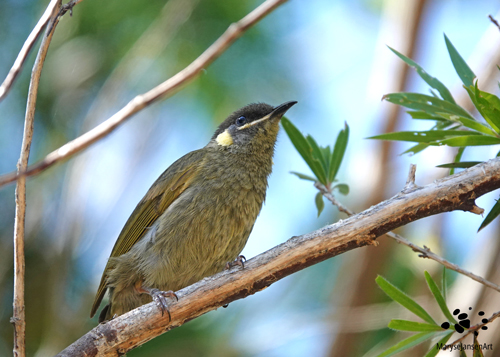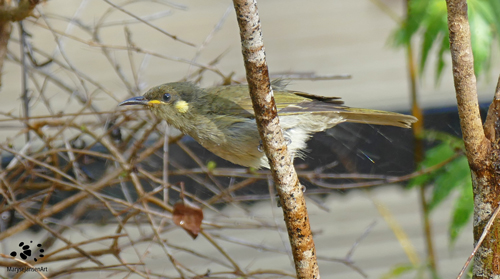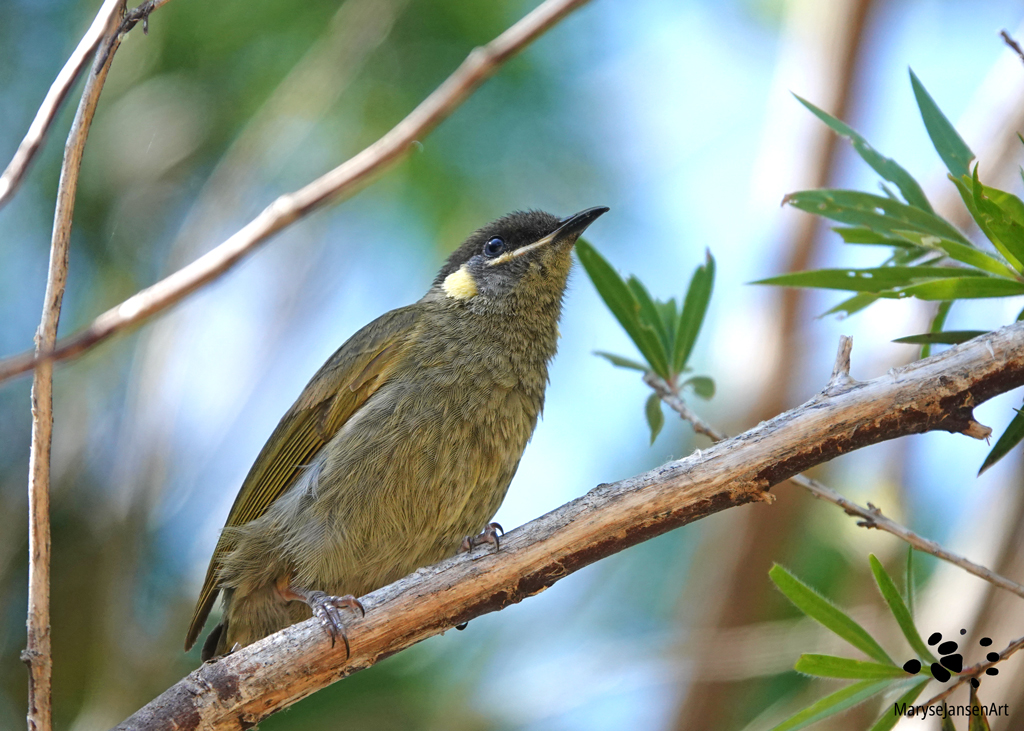Bird Photography with marysejansenart
Even experts have a hard time discerning three species of Honeyeater

Lewin’s Honeyeater more often heard then seen
Screeching calls emerge from the dense shrubbery on the river bank. Slowly I move in a bit closer to see what type of bird is making this noise. There is clearly a group of them, as I see the vegetation shake and move in different spots. Every now and then I get a quick glimpse of one of the birds. It is a Lewin’s Honeyeater! This is not its normal call, but rather a sign of alarm or annoyance. I’m not really sure what is causing the unrest as there is no sign of a predator. They might just be arguing amongst themselves.
The sound of their regular call has often been compared to a machine-gun, for the rapid succession of the repeated note. But it sounds a lot friendlier then that, I can assure you. You can listen to it below – note there are some Noisy Friarbirds in the background!
It is certainly a sound that carries, so it is helpful in detecting the Lewin’s Honeyeater in your area. However, these birds are more often heard then seen as they prefer to hang out in dense vegetation which is exactly what I’m looking at here!
How to tell the Lewin’s Honeyeater apart from two other, very similar Honeyeaters
The Lewin’s Honeyeater’s olive-greenish brown plumage certainly gives it good camouflage in these dark places. The thing that gives it away is the crescent shaped yellow ear patch. When that catches my eye, I know I have to do with a Lewin’s Honeyeater. But beware, it is not always that simple! When you venture into north Queensland, there are two other species of honeyeaters that look very similar to this one. They are the Yellow-spotted Honeyeater and the Graceful Honeyeater.
All three species are similar in colour and they all have a yellow ear patch. They can be told apart by looking at their size: the Lewin’s Honeyeater is the largest, being 19-21cm; the Yellow-spotted Honeyeater comes next with 17-19cm; and the Graceful Honeyeater is the smallest with 14-16cm. Now that is helpful when you see them side by side, but not very much when you only see one bird. The yellow patch has a distinct crescent shape on the Lewin’s Honeyeater which helps to tell it apart from the other two, which have a more rounded shape, usually… Apparently there is a fair bit of variation which makes it even more confusing.
There are also slight differences in the bill, where the Graceful Honeyeater’s bill is the thinnest and more down-curved, like in some other honeyeaters such as the Scarlet Honeyeater. The Graceful Honeyeater is also a bit lighter in colour when it comes to its underparts, compared to the other two species. But, really, even experts have a hard time telling these birds apart!
The best way to do it apparently, is to listen to their call! The Graceful Honeyeater produces a single note call, while the Yellow-spotted has a single note song as well as a high-pitched rattling call, but the rattling call of the Lewin’s Honeyeater is supposed to be a lot more vigorous!
During a trip in Cape York I encountered the bird in the image below, which to my best ability I will identify as a Yellow-spotted Honeyeater. Seeing it next to the image of the Lewin’s Honeyeater I think it is quite obvious that there is a difference. However, I do not have an image of a Graceful Honeyeater to compare it with. I am going with the shape of the bill here. What do you think?

Habitat and Breeding Habits of the Lewin’s Honeyeater
Thankfully, today identifying the bird is easy, because I am in south-east Queensland, which is way out of the range of the two northern species. The Lewin’s Honeyeater is the only one that can be found here, and it ranges all the way south down the east coast of Australia. As I mentioned, it prefers a habitat of dense vegetation and it also likes a wet environment. You may spot it in rainforests or wet sclerophyll forests. While other birds take shelter when it rains, this one functions rather well in the rain!
The Lewin’s Honeyeater feeds on fruit, insects and nectar. Usually you will see them alone, but occasionally they will form small groups, like today.
Interestingly, not much is known about the breeding habits of these birds. They build a basket nest a couple of metres above the ground but it is unclear which of the sexes are involved in the building activities. It is also not known which of the sexes are involved in incubating the 2-3 eggs. It takes 2 weeks to incubate and another 2 weeks for the chicks to fledge. Both the male and the female look after the chicks.
You may recall we watched a Lewin’s Honeyeater diligently preening its feathers to look good on camera when we walked in episode #29 of ‘Come for a walk in the Australian Bush’ (click here if you’ve missed it). In this week’s episode we will see some birds from the little group I described above. You can watch it below!
If you are interested in purchasing the featured image ‘Lewin’s Honeyeater’ or would like to see what it looks like on the various products, please head to my shop.
Check out my post about another Australian Honeyeater, the Noisy Miner, here.


